A heartfelt thanks to everyone for their lovely comments! It was like turning on the light in what I thought was an empty room, only to find it full of friends! 😉 I love that many of you said you were enjoying the tour through Portugal, as like-minded travel companions, arm-chair or otherwise, are a treasure. Only a couple of “unsubscribers” hopped off the train at the last stop, so off we go back to Portugal…
When doing research on “don’t miss” places along the Portuguese coast, Tavira, along with the expanse of barrier islands off her coast, comes up consistently as a recommended stop. Reputed to be one of the most charming towns of the Algarve region, Tavira is billed as offering a completely different ambiance than some of the more heavily touristed party towns along the coast like Albuferia and Faro. Since its six mile stretch of beaches lie offshore, accessible only by ferry, it feels a bit more pristine than other towns where the beach butts right up against heavily trafficked roadways, condos, and golf courses.
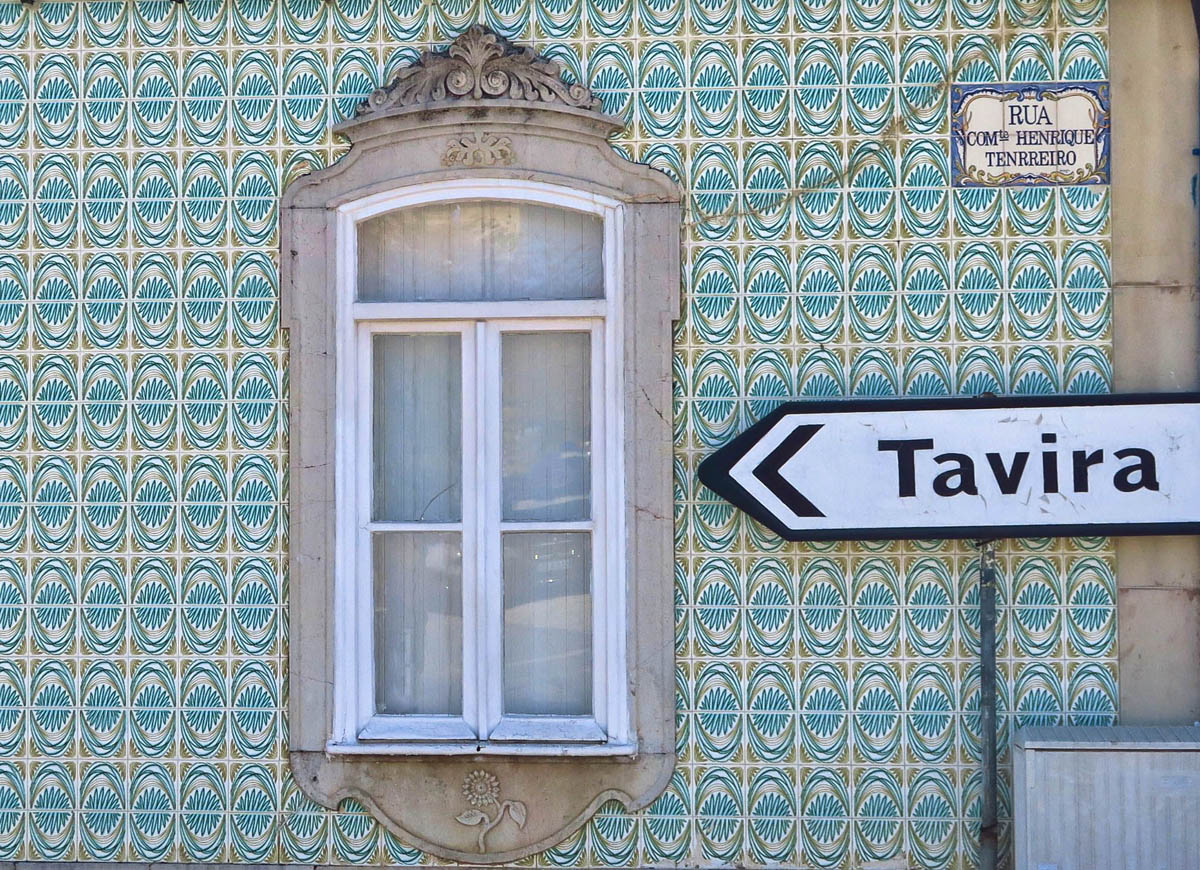

Getting from Lagos to Tavira is easy, whether by bus, or in this case, commuter train which runs along the coastline.
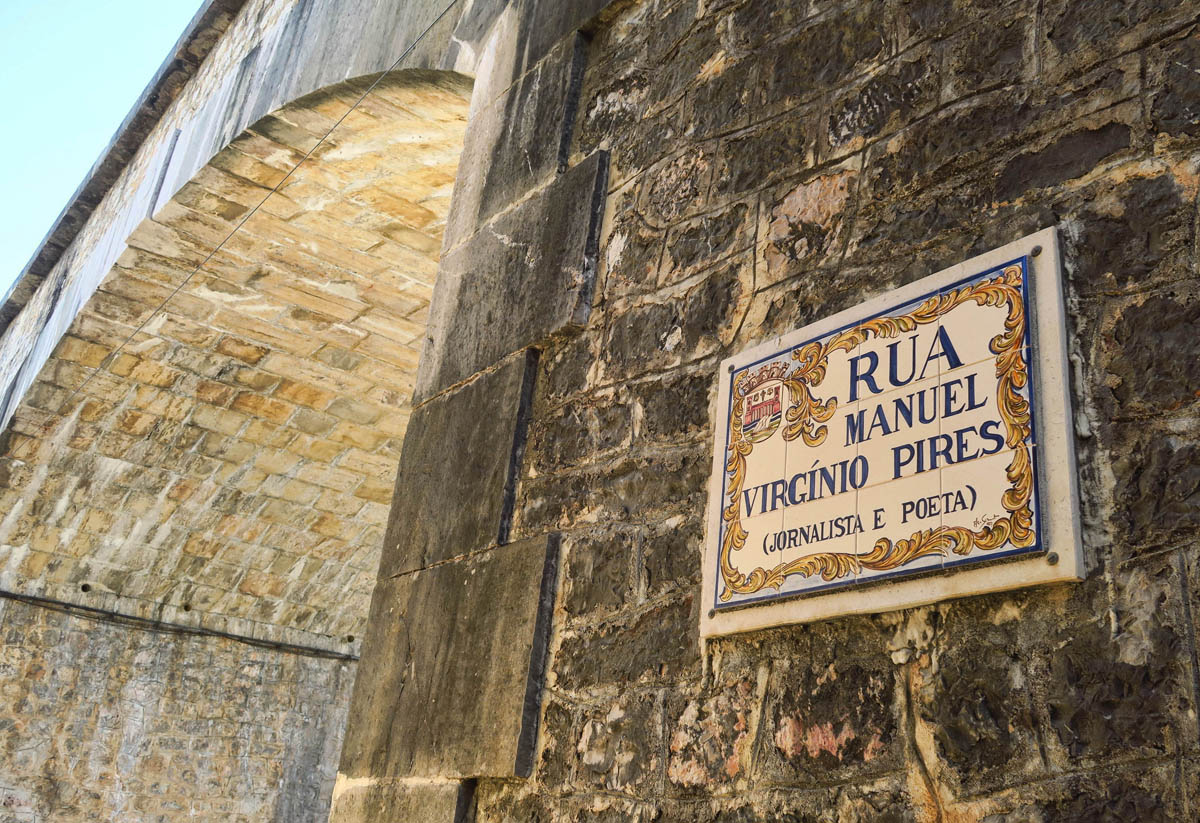
I adore the fact that my commute from my guesthouse to the main area of town is along a street named for a “Journalist and Poet.”
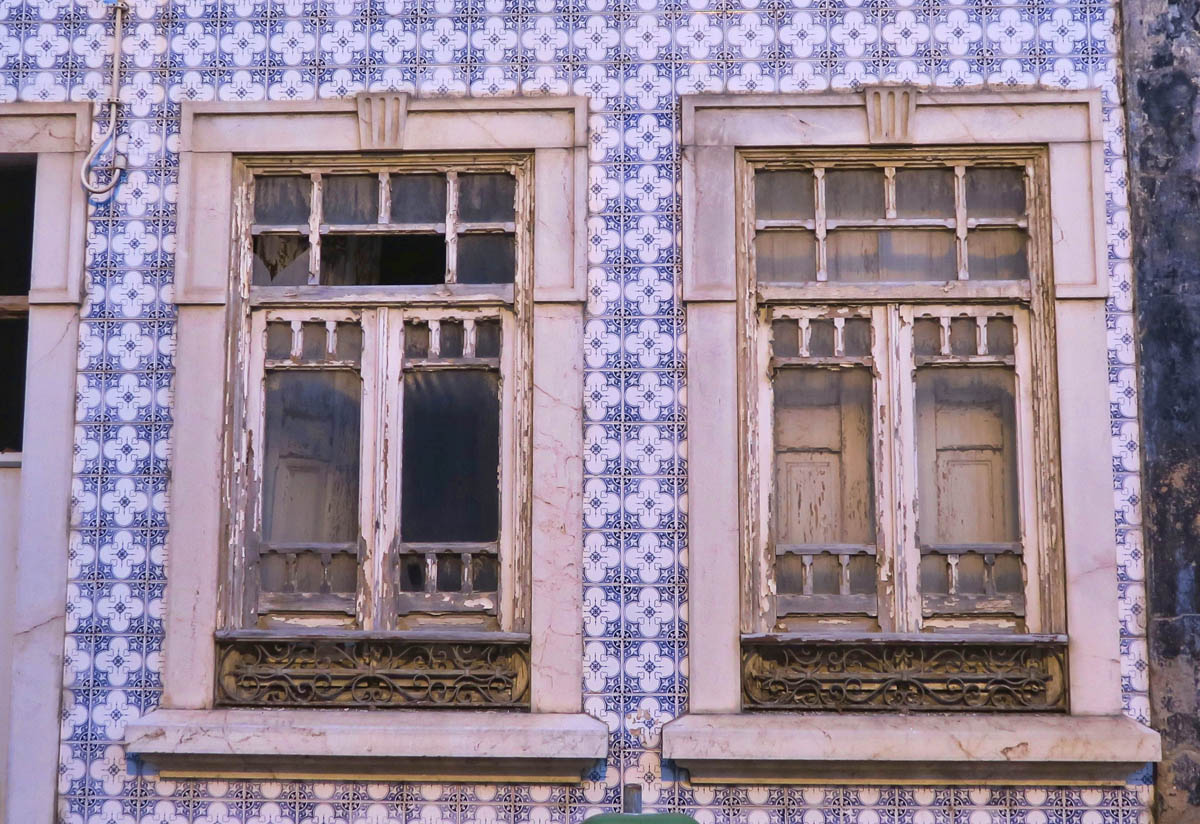
I don’t think I would ever tire of the beautiful architecture and tilework in Portugal.
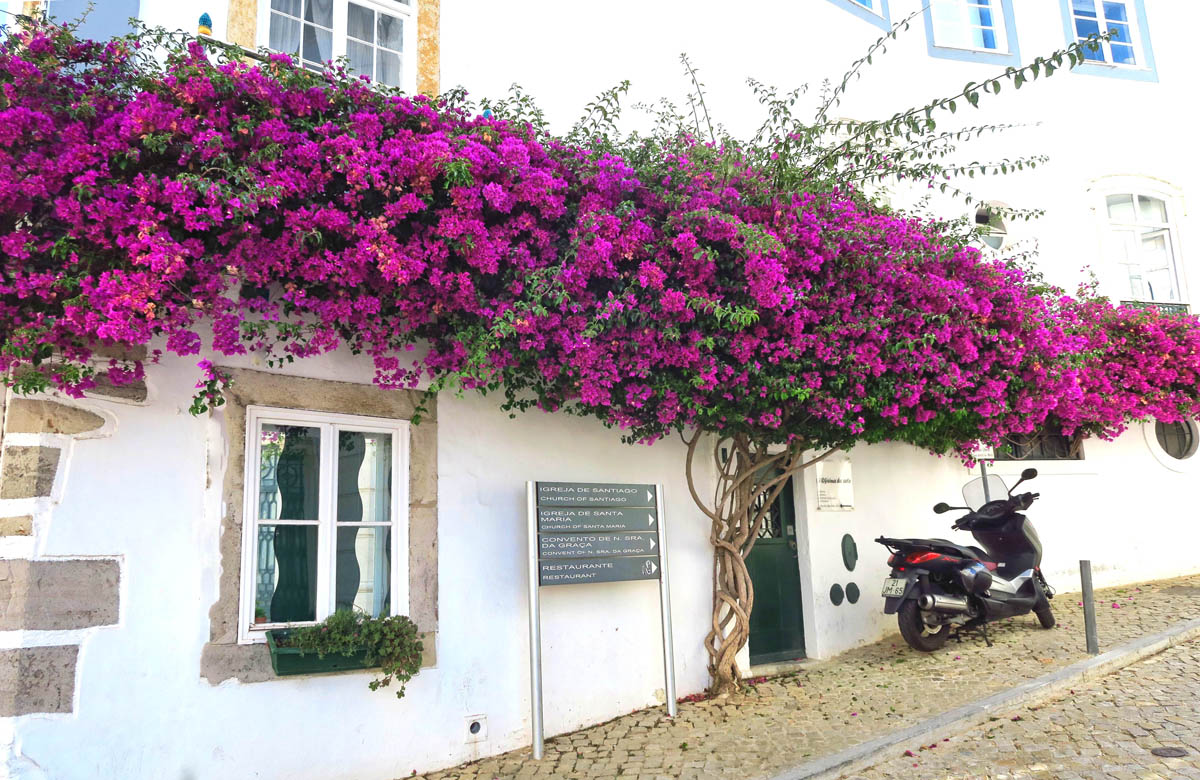
The old part of town sports a more “Mediterranean” look with whitewashed walls and brilliant flowers.
The main old town of Tavira, made up of cobblestone streets and whitewashed Moorish architecture, straddles the Rio Gilão, with most of the outdoor restaurants and bars centered around the Ponte Romana, or Roman Bridge built in 1667. Billed as a coastal destination with more understated ambiance and more “day life” than nightlife, Tavira sounded like my kinda place. I booked a week in the lovely Varandas Guest House to explore the area.
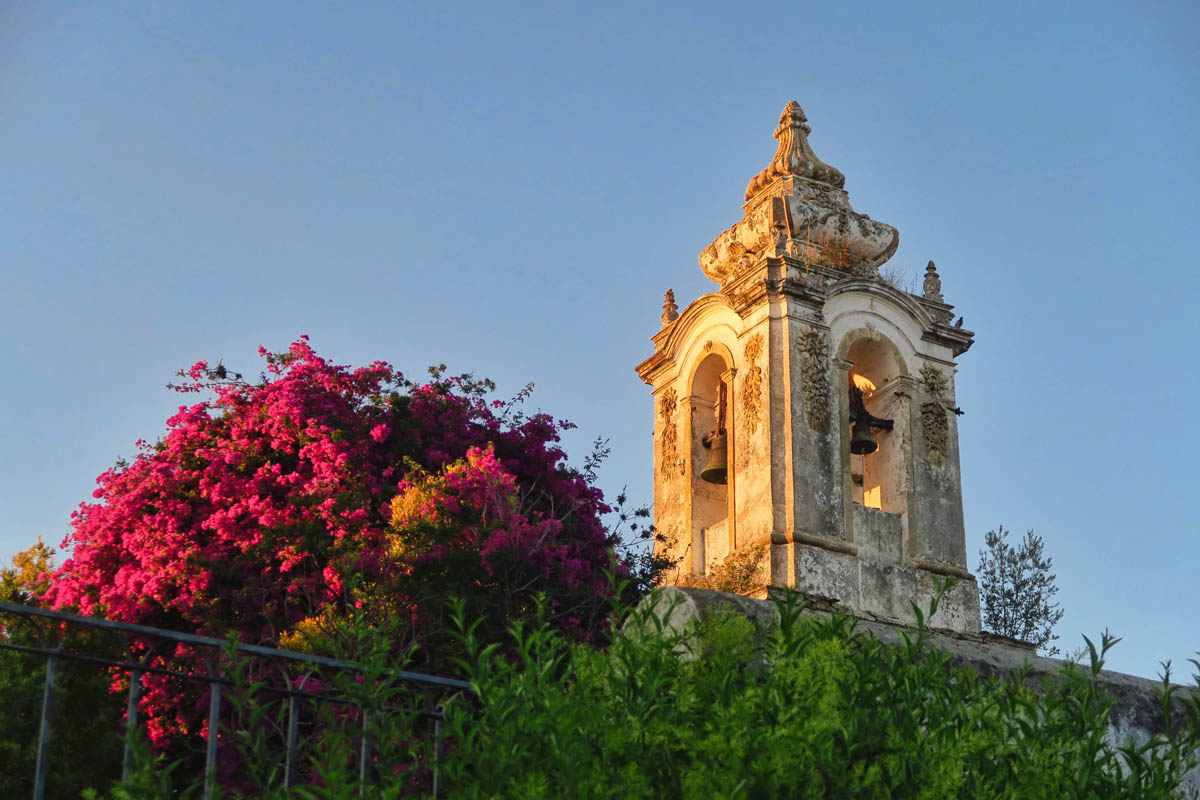
Lots of old world charm in the small town of Tavira.
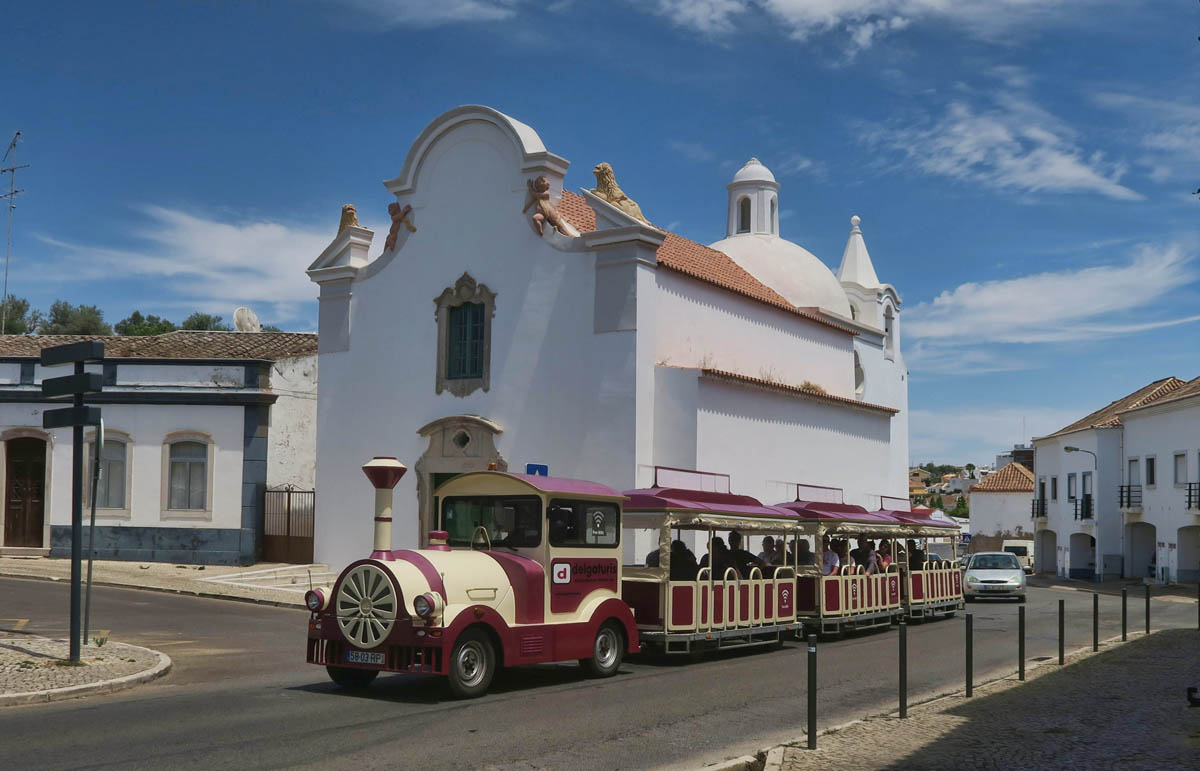
Like several towns in Portugal, there is a small tourist train.

Musicians pop up throughout the old town.

The gorgeous Igreja da Misericórdia (Church of Mercy) built between 1541 and 1551.

The azuelos, or blue tiles lining the walls depicting the “works of mercy” were believed to be added in the 1760’s.
By now, I have settled into guesthouses as my preferred accommodation rather than more expensive hotels. Guesthouses are prolific in Portugal, as owners have converted entire apartments or condos into rentable bedrooms, often offering both shared and private bath, typically with a shared kitchen area. Some like Varandas even offer continental breakfast. These accommodations are easily booked through on online booking sites. I prefer to use booking.com, because they have a check box that allows me to select private rooms only, rather than weed through dozens of dorm rooms. There one can view photos of the rooms, view the property on a map, and read travelers reviews. And there is a “Booking Assistant” that once booked, enables you to exchange information with the property about easiest method of arrival, special requests, etc. Booking onward accommodations could not be easier in Portugal. (If you are new to booking.com, use this link and we both get twenty bucks back after your first stay!)
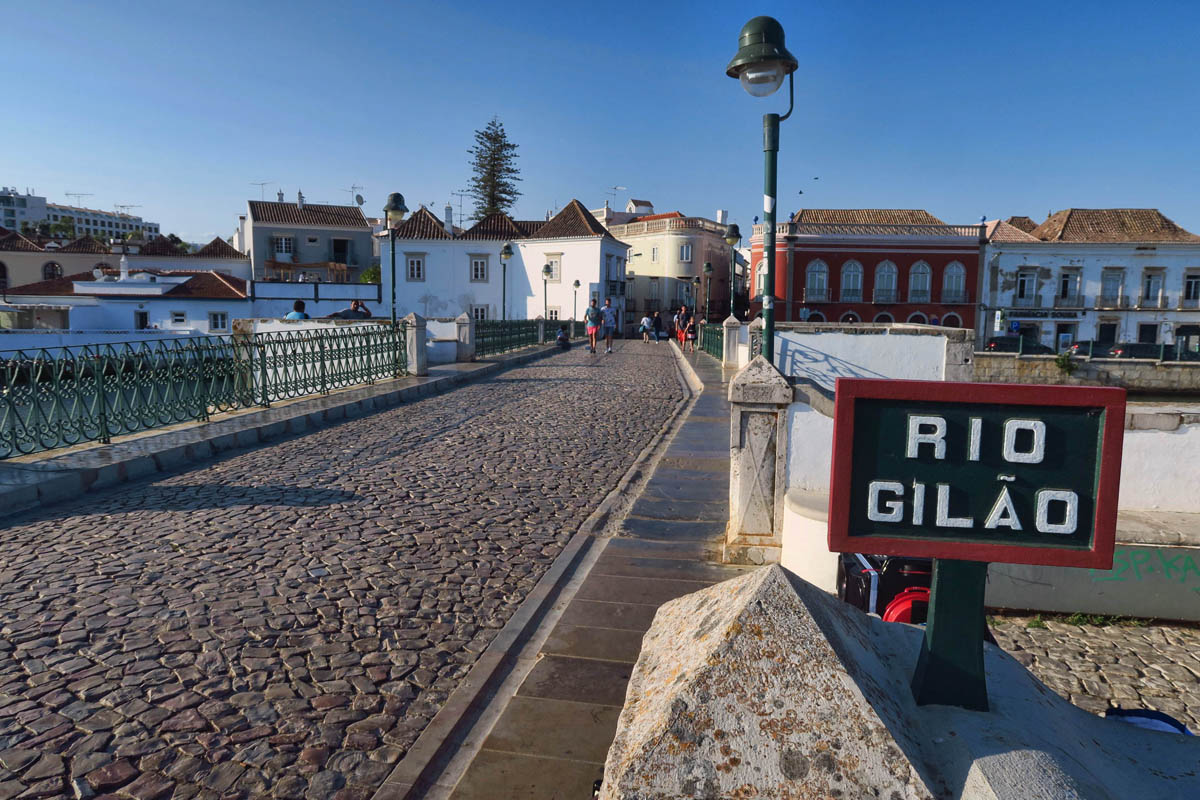
Many quaint bars and cafes are located on both sides of the Rio Gilao.

The old Roman Bridge is pedestrian-only.

Note swimmer in the river alongside one of the many outdoor cafes.
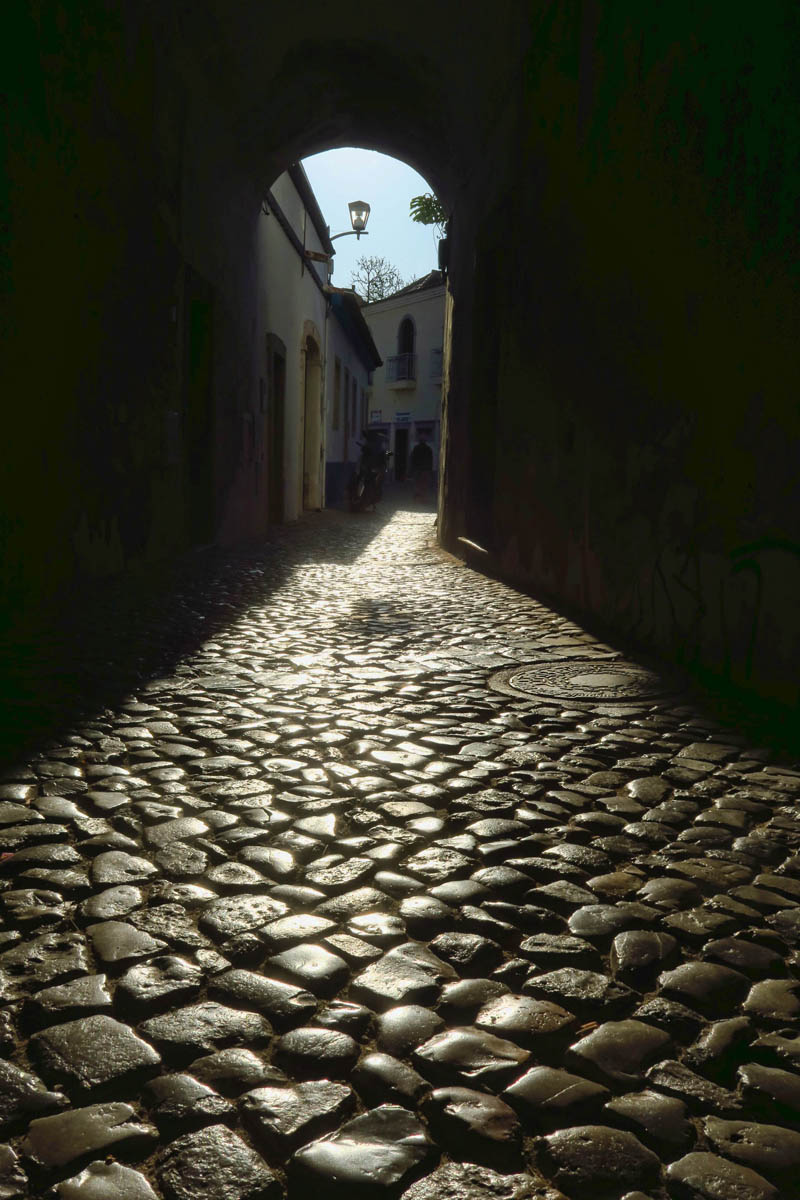
Lots of ancient cobblestone streets…
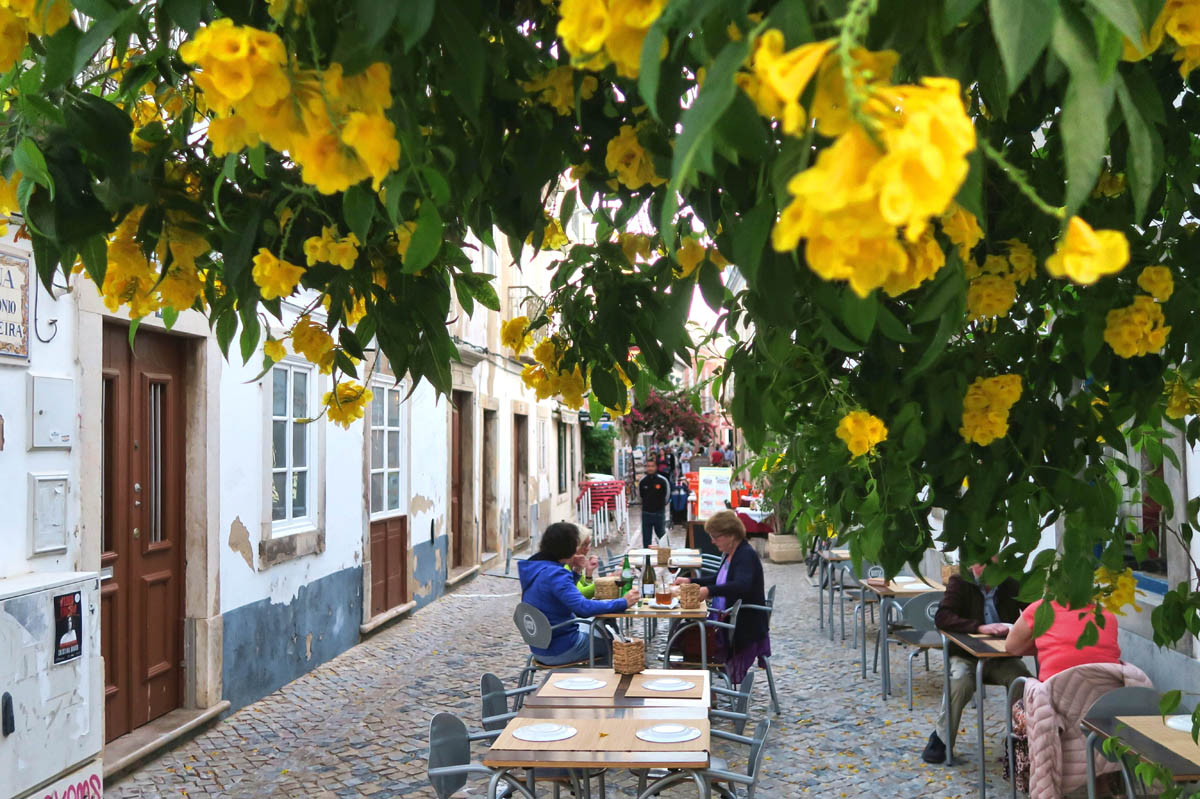
…lined with picturesque outdoor cafes.
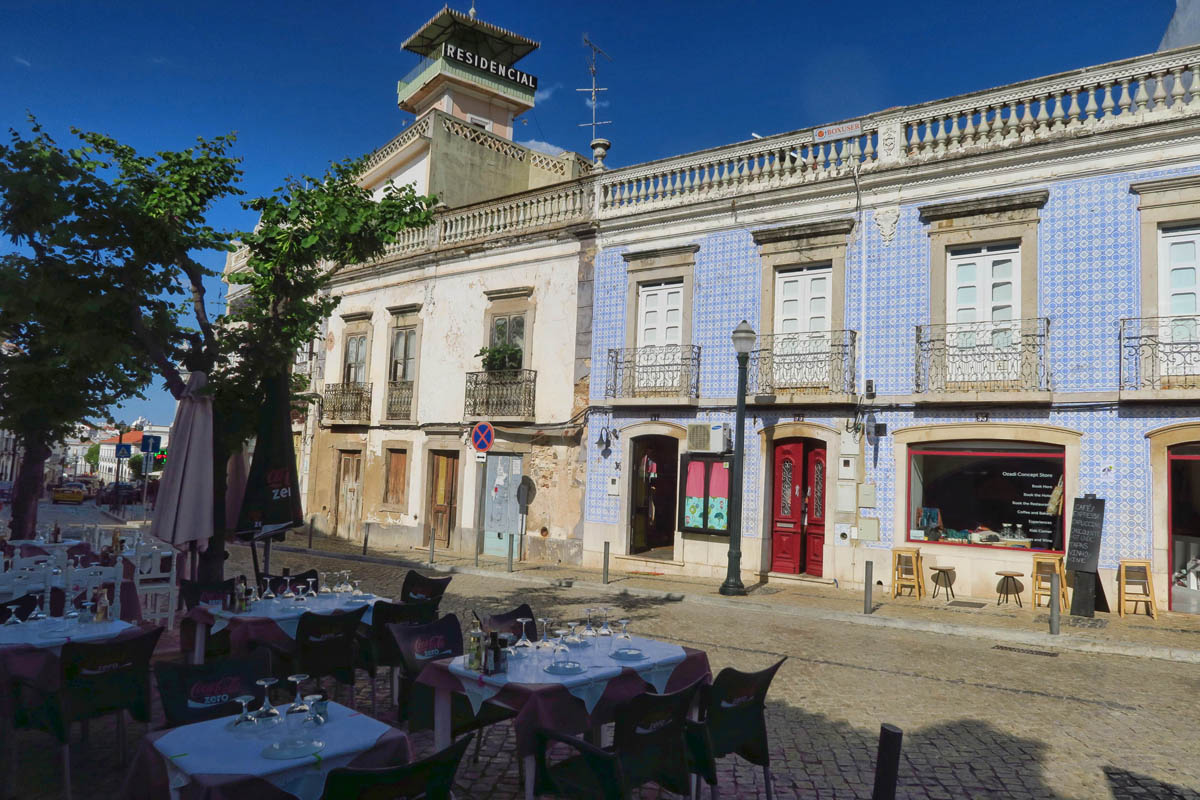
One of the many things I have come to love about Portugese dining is that there is always a full compliment of wine glasses on the tables, even those outdoors!
Praia da Ilha de Tavira, the main beach off of Tavira, is accessed by a 20 minute ferry which leaves from the river inlet downtown. It costs €2 round trip, or €1.30 one way, and runs every half hour until noon, at which time it runs once per hour. The roadless barrier island beaches run parallel to the mainland for a total of six miles.
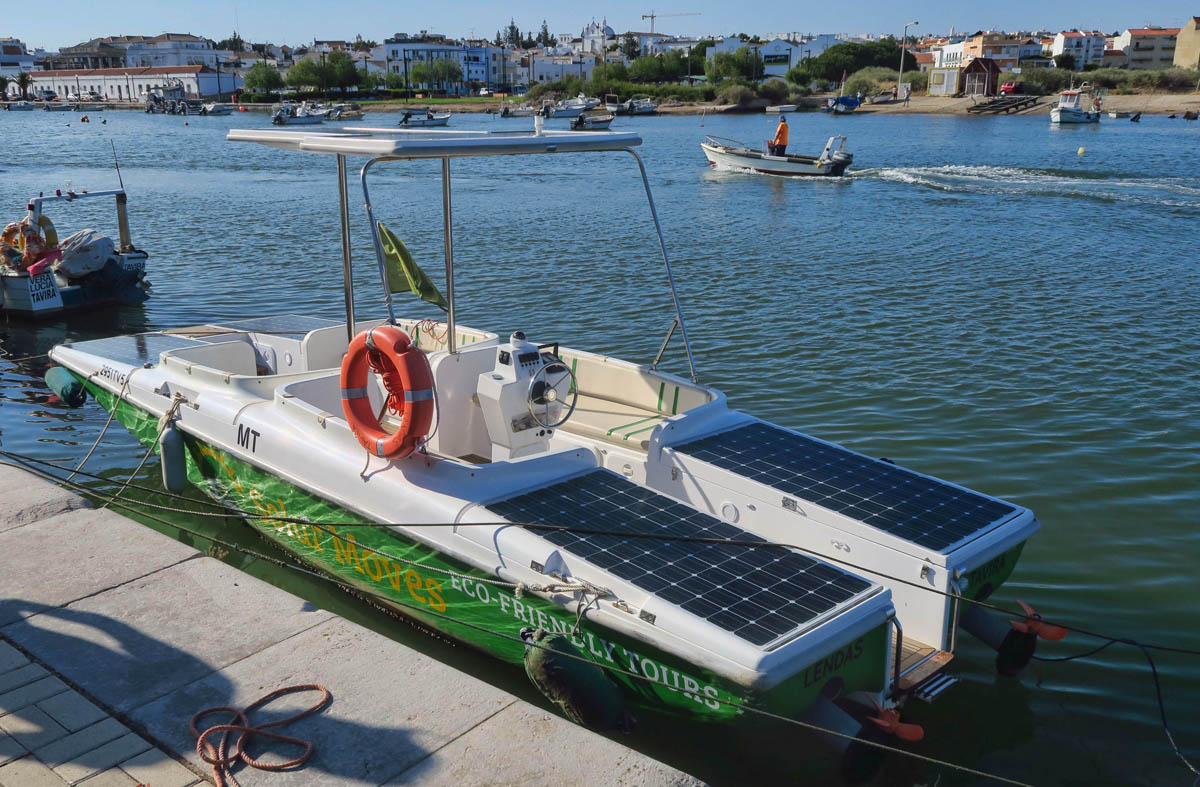
Love this solar-powered boat offering tours of the Rio Formosa Nature Park and estuary.
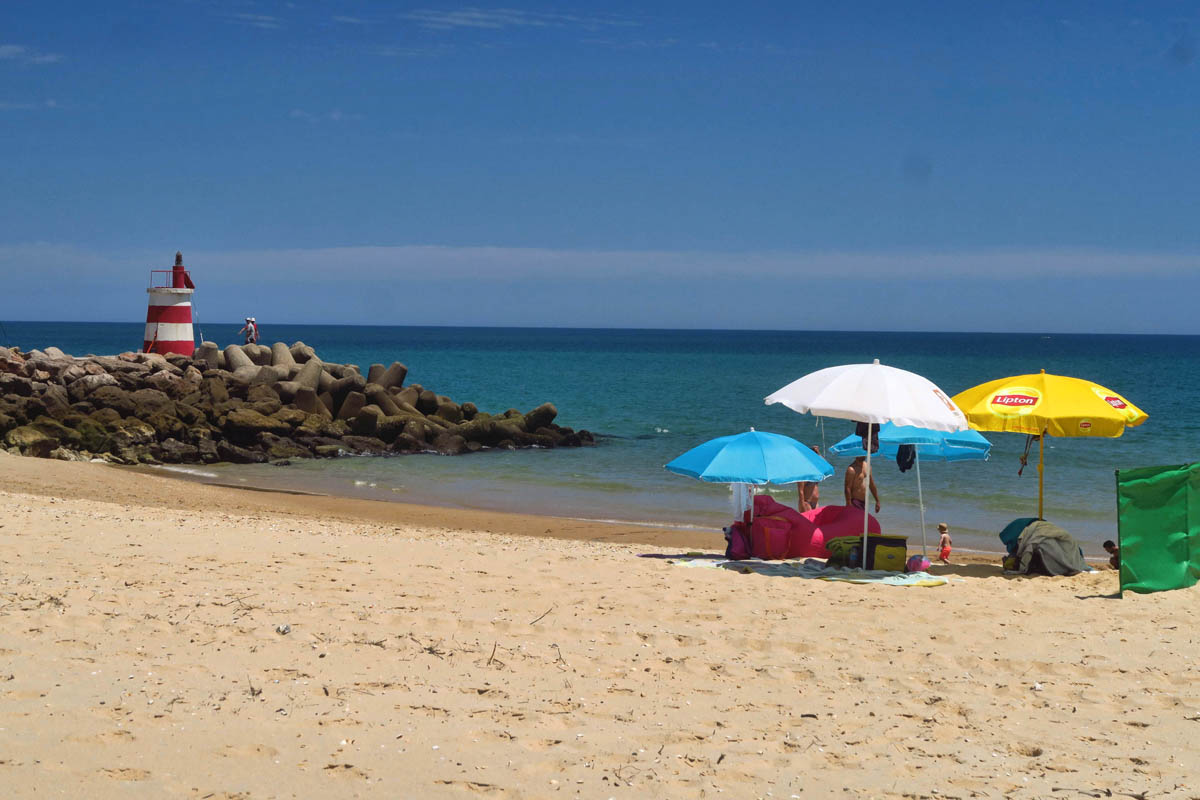
Praia da Ilha de Tavira translates to “Island of Tavira,” part of the barrier island.
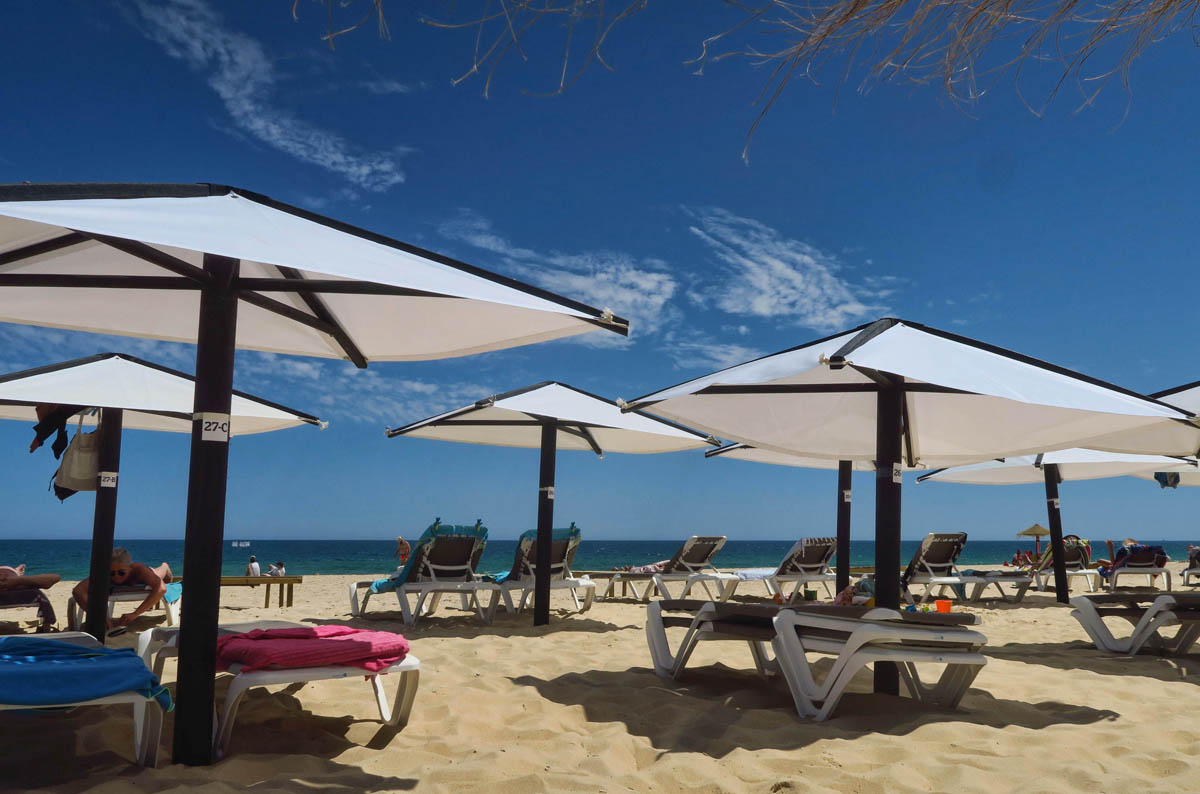
Once you reach the island, the beach has ample services with lots of seafood restaurants, bars, a mini-market, and chairs and umbrellas for rent.
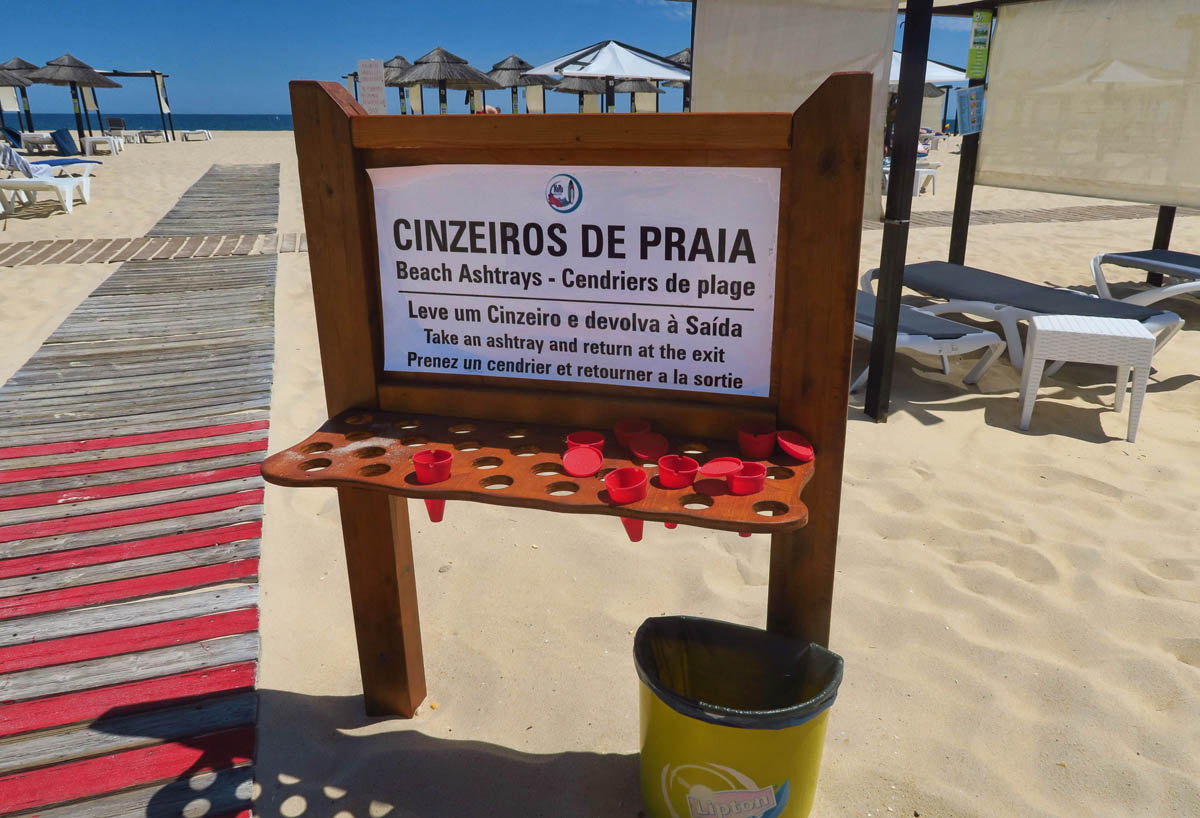
This is SUCH a great idea for the beach! Free ashtrays…take one, empty it, and return it.
While on walkabout around my guesthouse, I discover an alternative access to the beach without having to be governed by the ferry schedules…WALK! As the barrier island tapers west, the gap filled by the wetlands and bird sanctuary, Rio Formosa Nature Park, narrows enough to make the island accessible by footbridge. I found a lovely 3 mile gravel path from Tavira to Santa Luzia that cuts through orange, lemon, apricot, and fig orchards, which on a dry sunny day reminds me of the final scene in the Godfather where Vito Corleone falls out of his chair, dead, with an orange peel in this teeth. The walk through the orchards is part of the “Ecovia do Litoral,” or the Algarve Cycle Path, which “T’s” into a beachside bike path connecting the small villages.
Once you reach Pedras de El-Rei, a footbridge leads to the depot of a small mini-train that will take you the remaining mile to Barril Beach, or that stretch you can also walk. It’s a little over a five mile walk in total from Tavira to Barril Beach, but there are also buses that run from Pedras de El-Rei and Santa Luzia to Tavira main bus station for €2.30, making a one way walk possible. (Note, as is often the case in Portugal which seems contrary to tourism, there are no buses on the weekends. Only M-F.) And if you plan your timing early enough in the day, you can return via the beach and take the ferry back to Tavira. Or better yet, rent a bike!
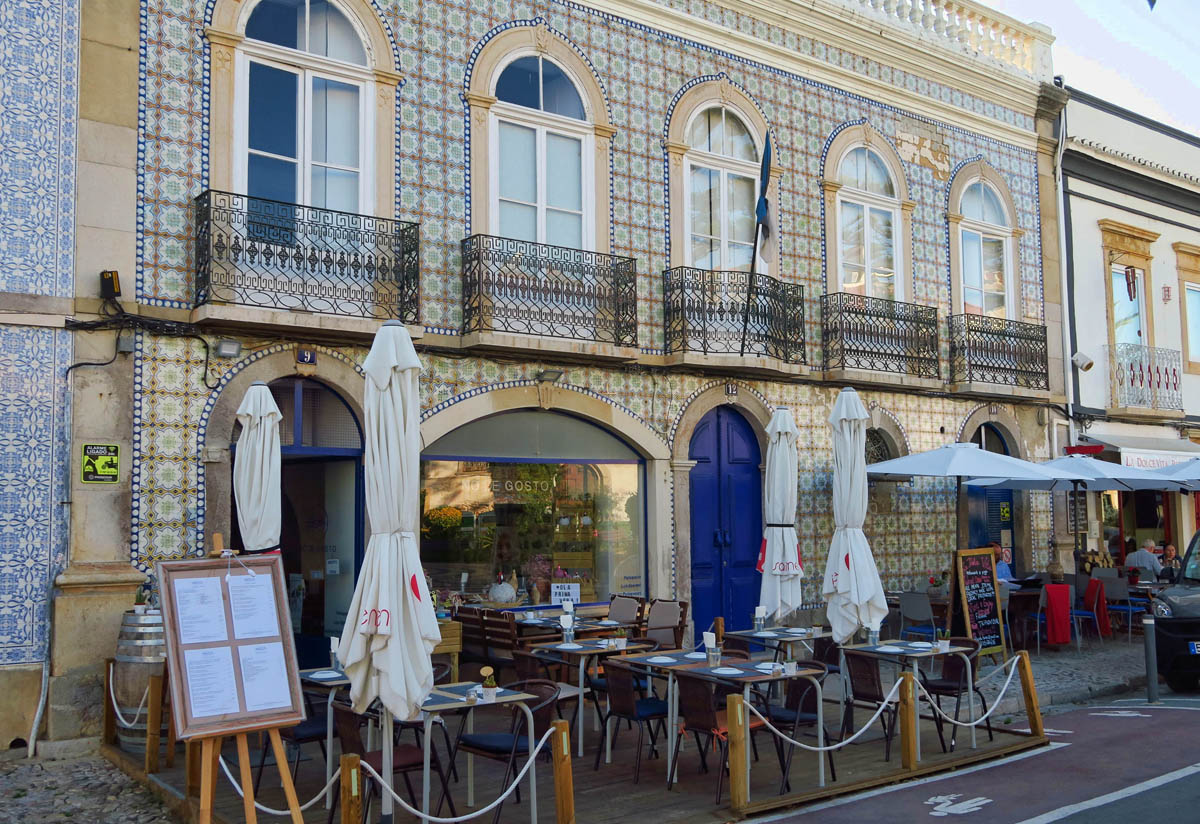
I have the good fortune to have arrived in Tavira in time for the Festival de Gastronomia do Mar (Seafood Festival) where over 50 restaurants participate in featuring a Mediterranean diet and local seafood menu. This restaurant, “No de Gosto” was one of my favorites.
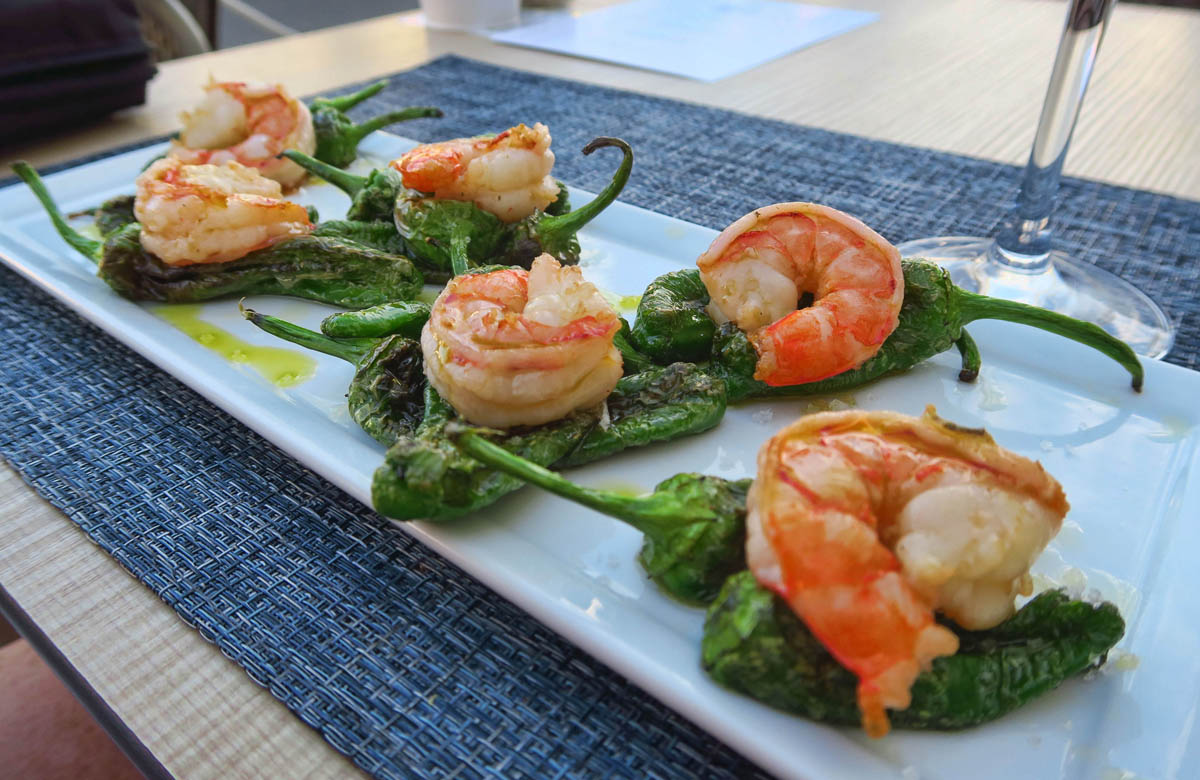
Their featured entree, “Talvez Pik” was scrumptious. The padrão peppers were mild and flavorful with no heat.
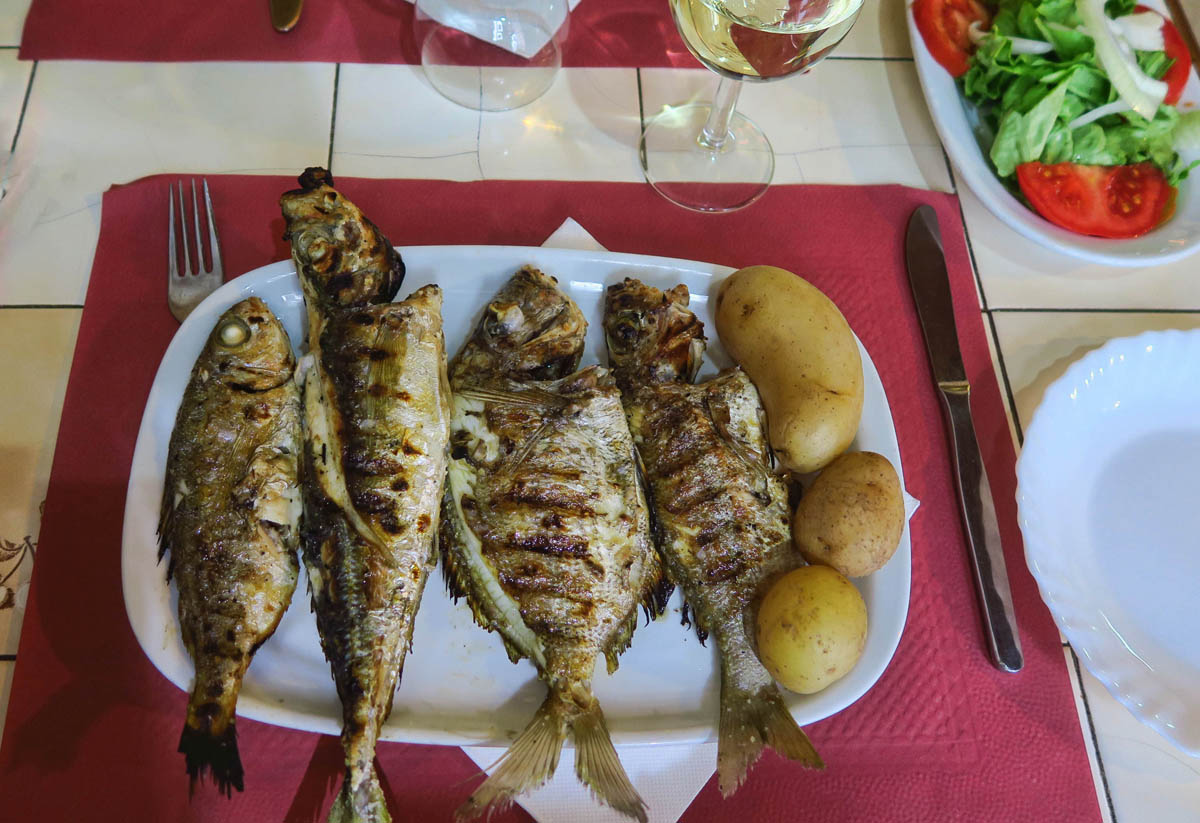
And the waiter at the rustic Petisqueria Belmar restaurant cracked me up. Him: “The special today is ‘mixed fish.” Me: “What kind of fish?” (meaning species) Him: “Grilled.”
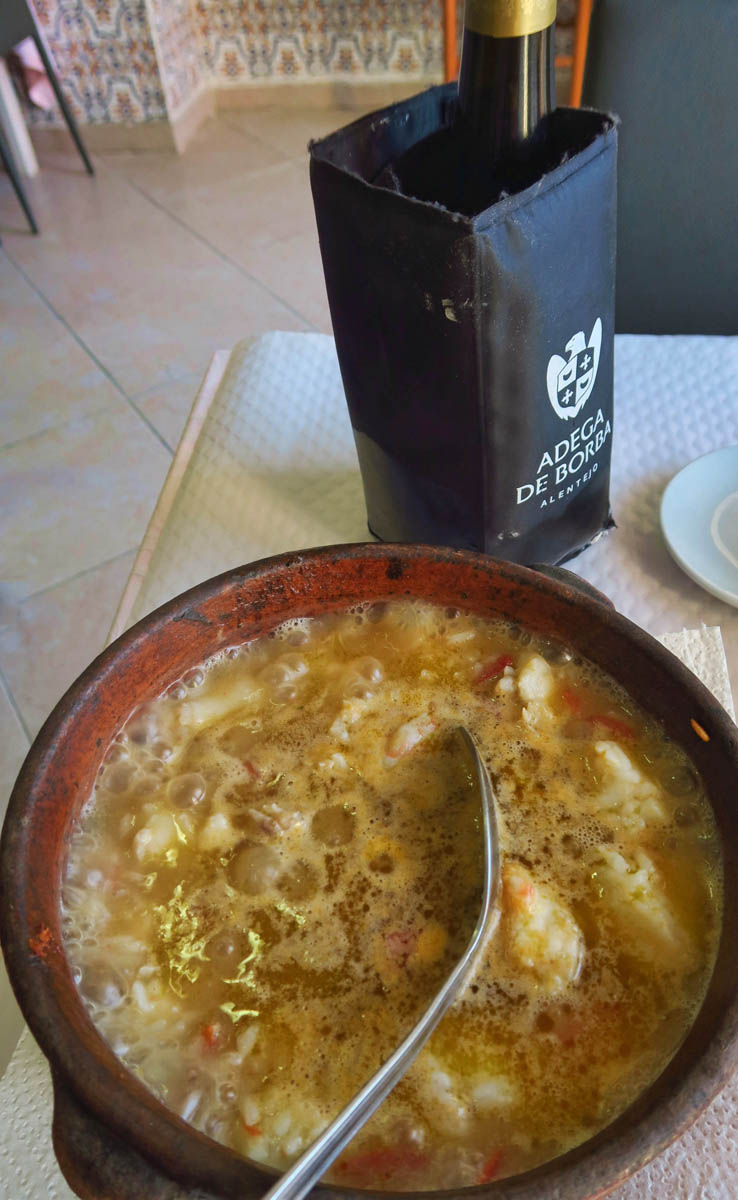
But the bubbly, buttery, steaming Arroz de Tamboril com Gambas, or Monkfish Rice with Prawns at Joao Belhi along the inlet was my favorite.
Along my walk, I visit nearby Santa Luzia, a tiny Portuguese fishing village known for its traditional octopus fishing (polvo in Portuguese.) Competition is tough along the main street lined with family-owned restaurants featuring an octopus-dominated menu. They know how to do octopus right in Portugal. While always somewhat tough and rubbery in my past experience, I never sampled an order of octopus in Portugal, whether grilled, fried, stewed that wasn’t succulent. (I don’t typically eat octopus, as being a scuba diver, I have come to know it is one of the most intelligent creatures in the sea, a master of disguise, and an intrepid hunter. However, I gotta say it; ”When in Portugal…”)

Walking the docks in Santa Luzia gives a good impression of traditional fishing methods.
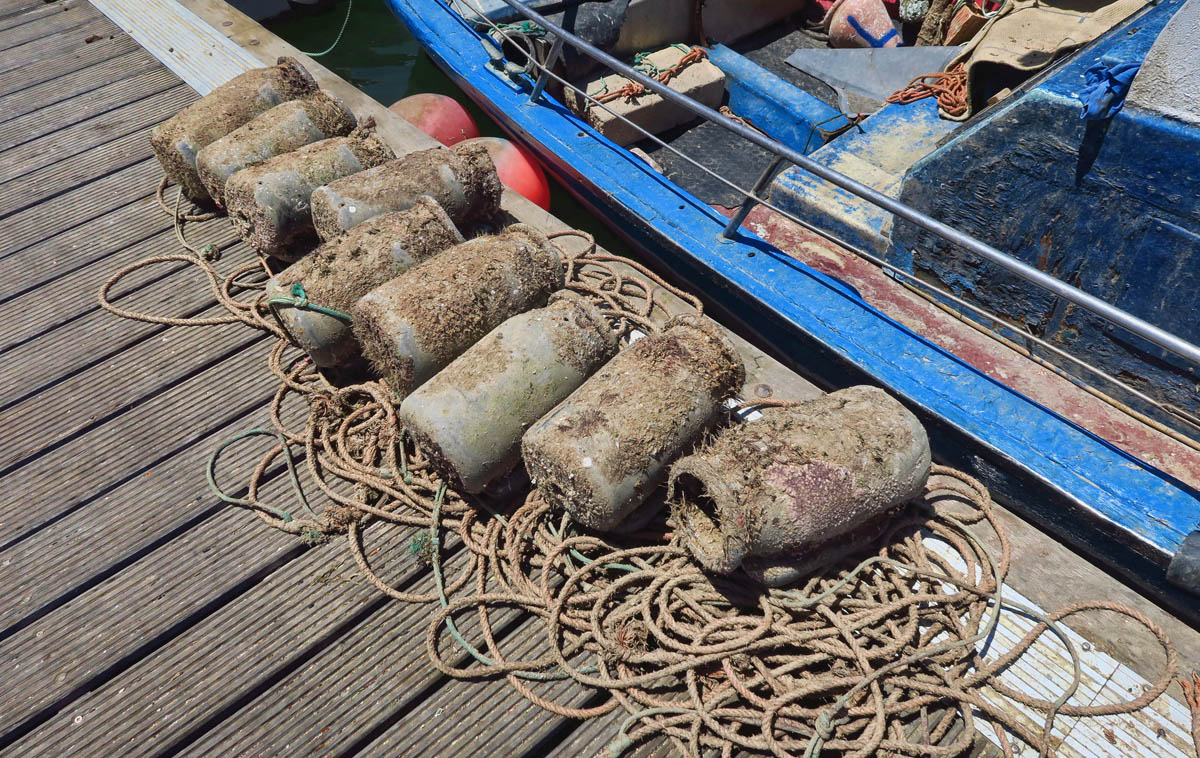
Clay pots are used for catching octopus. They swim in to hide.
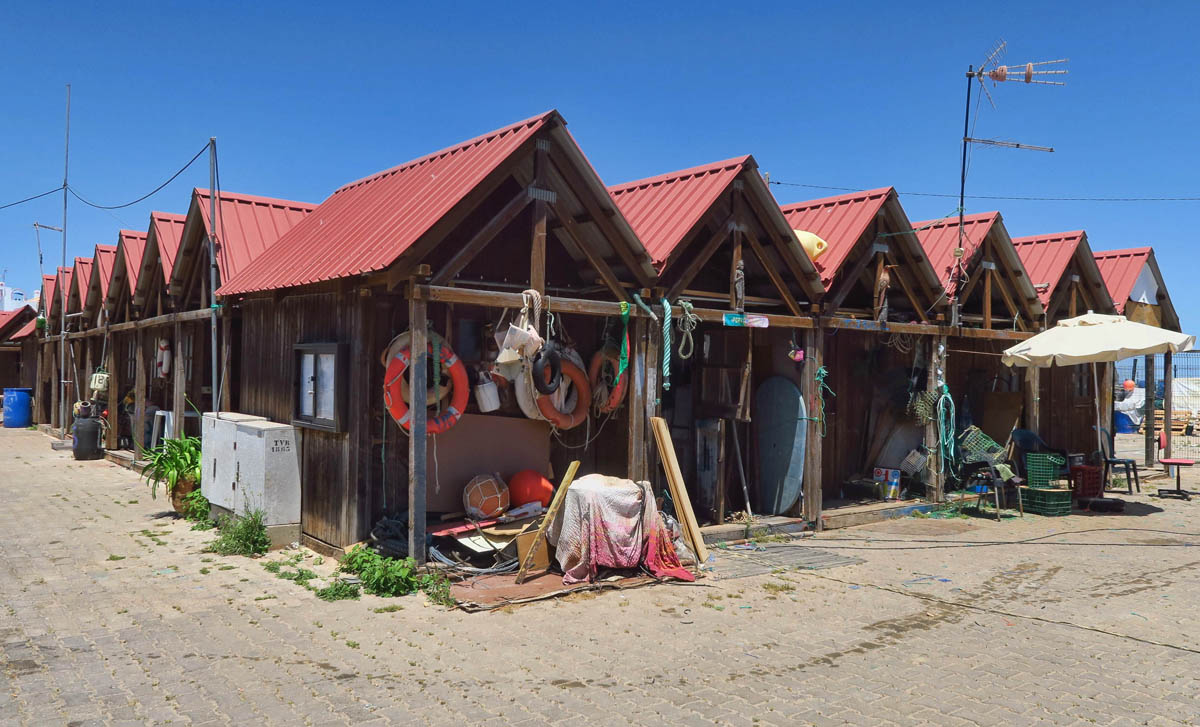
Rows of fishermans huts are a part of the main village.
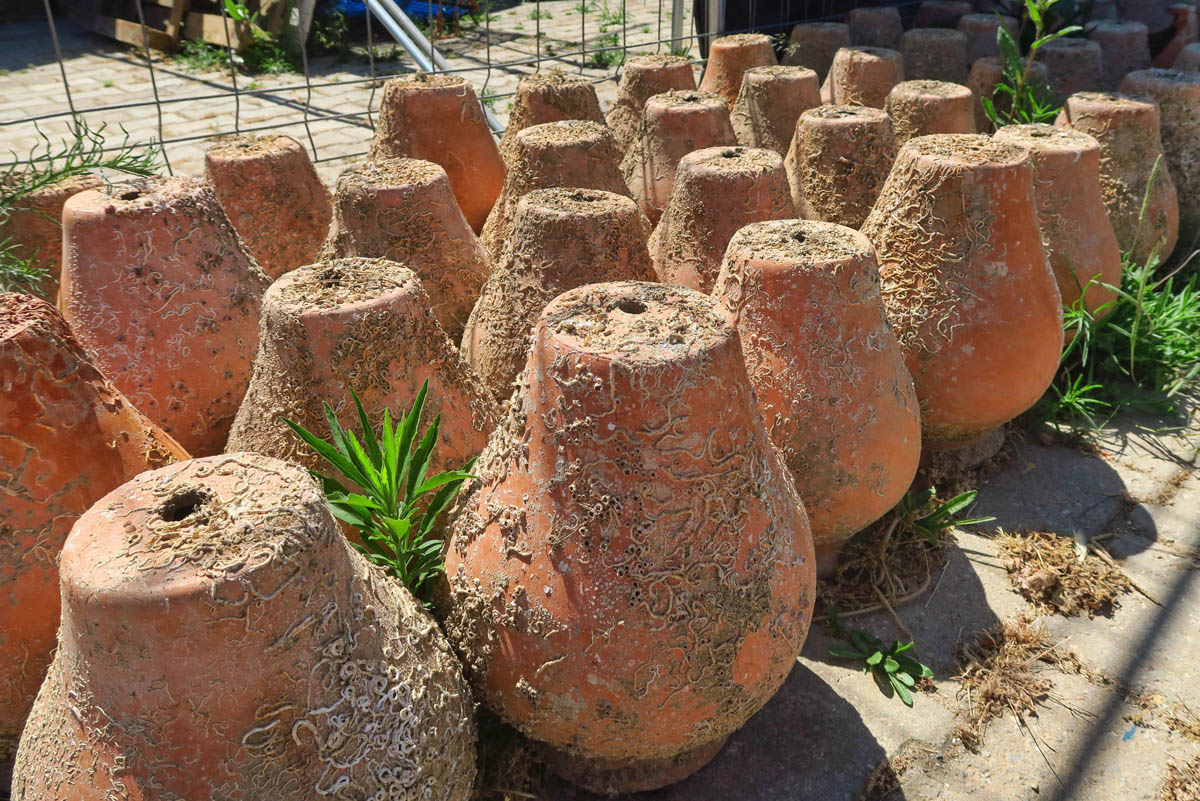
Clay octopus pots drying in the sun.
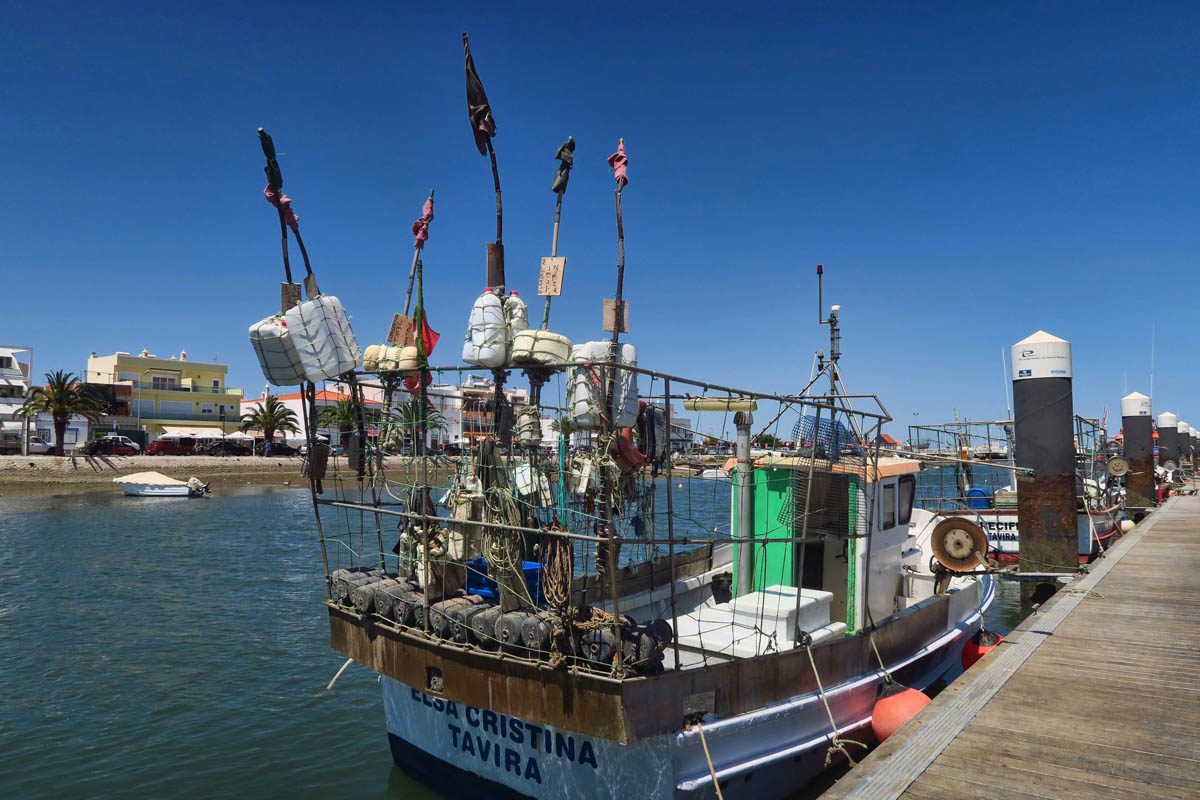
Many unique techniques in play here.

I am not sure about these traps. Maybe lobster or crab?

After lunch, the tide comes in and these boats are once again afloat.
Yet another ferry goes from Santa Luzia to yet another beach, Praia da Terra Estreita. But I keep walking….
Just a bit further west from Santa Luzia is the tiny hamlet of Pedras de El-Rei, which consists of little more than a resort complex and a bus stop. Here, the footbridge leads to Praia de Barril, or Barril Beach, my ultimate destination for the day, as I want to visit the Cemitério das Âncoras, or Anchor Cemetery. Barril Beach was once the location of a small tuna fishing community. The former fishermen huts have been converted into a few small cafes and shops, while the rusting anchors have been laid out in an artful grid to serve as a memorial to the bygone blue fin tuna industry. Traditional tuna techniques involved stringing giant nets, anchored by these giant rusting relics. The industry was not sustainable, and no blue fin tuna remain in the area today.
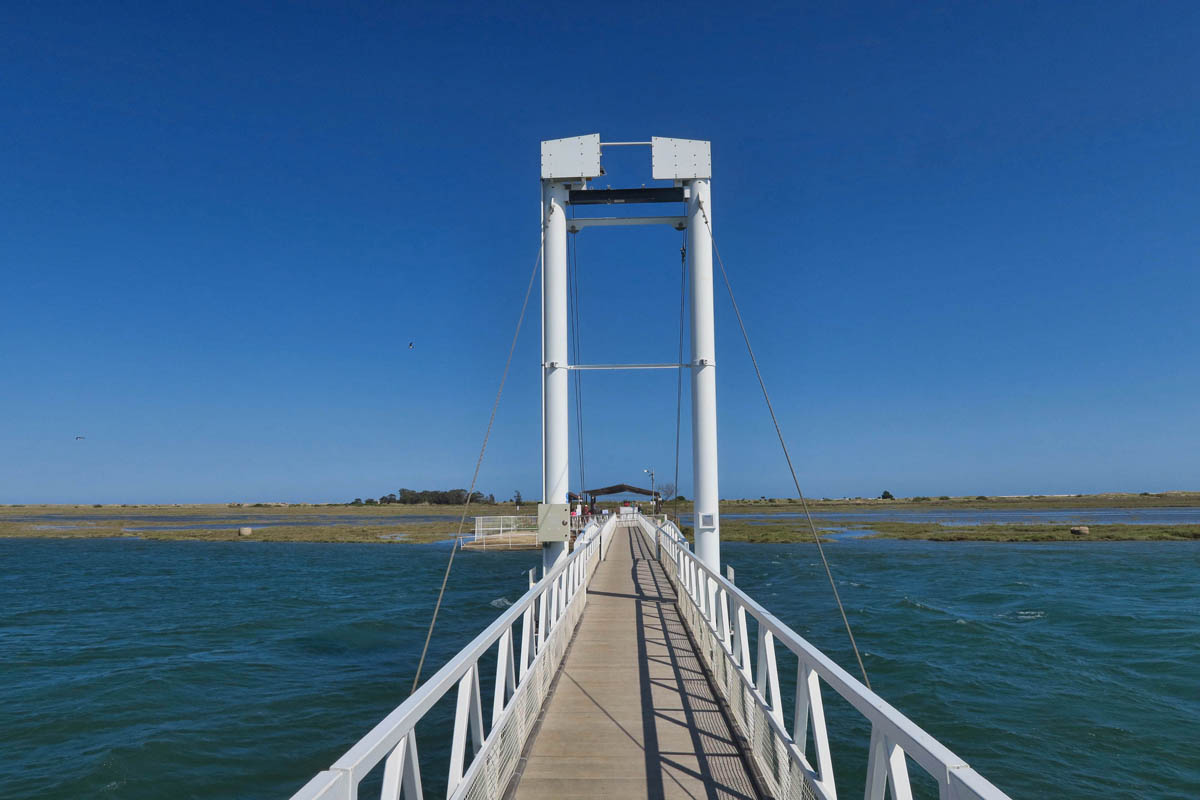
Footbridge connects Praia do Barril, or Barril Beach to the mainland.

Once across the bridge, it’s another mile to the beach. One can either walk it, or for €2 take the mini-train that was once used to haul goods and freshly caught fish between the fishing community and the village of Pedras D’el Rei.
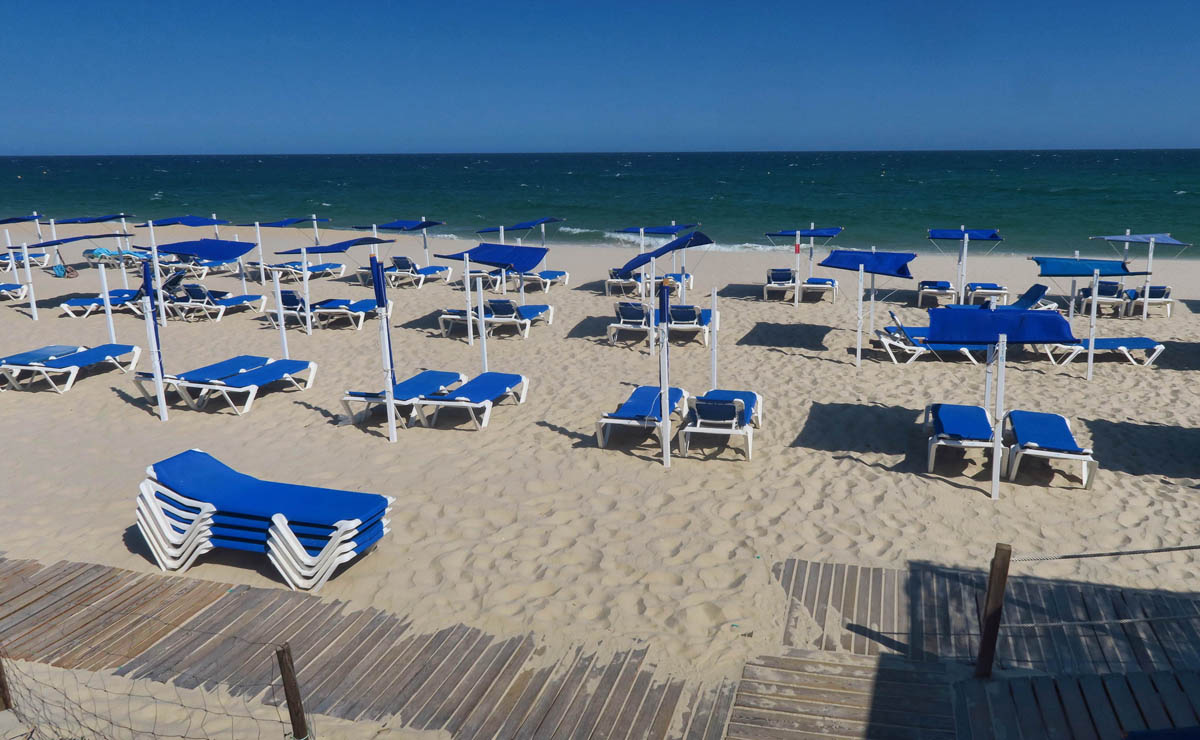
No people on the beach today, as high winds make it a bit too chilly.

The Anchor Cemetery is impressive with 250 giant anchors, rusting in the elements.
Tavira certainly offers lots of options for dining, live music, outdoor bars along the river, and beautiful beaches. While one must work a little harder to reach the Atlantic Ocean here, the effort results in a less crowded, pristine locale one often finds on barrier islands. I think it’s worth the effort to get there.

What a lovely little sea port, thanks for exploring it so well and making me want to sample their octopus which I have never experienced as anything but rubberbandy. (my word).
Same thoughts Allen, always declined octopus on the menu due to complaints about being rubbery plus being a SCUBA diver I pity those elusive guys ending up on a plate instead of under a rock in the sea. Suzanne I always wondered how they caught octopus because they’re so good at hiding and being safely tucked away out of harm’s reach, so now I know . . .
Even though I can see Mexico from my backyard, my one very short excursion there did not bear repeating. Italy . . . interesting, but not interesting enough. Well, maybe northern Italy with direct proximity to Austria, Germany, France and Belgium . . . but Portugal has always been the wild card for me.
You’ve brought it all into focus. How long would it take to get there from Arizona by boat? ;-> I’d even try the octopus and Mixed Fish. Will you be publishing a guide book to Portugal?
Virtual hugs,
Judie
Thank you, Suzanne! Love your photos and travel tips!!
Thank you for taking me to a place I’ll never be able to go. It’s so beautiful there and you captured it so perfectly.
Love the cobblestone photograph. I’ve been patiently waiting.
I found that photo outstanding. My eye was instantly attracted to it.
Well done, Suzanne. Keep the stories coming. I am linking this to my friends.
One of the things that amazes me about you is how you notice the little things that many of us would miss and your insights into everything. You have an amazing mind and spirit. Thank you.
Tavira, eh. I’ll be in Ayamonte in 3 weeks, so I’ll check it out. Thx !
My “sense” of humor tells me to write OMG not more Portugal!!!
But your writing is so engaging and descriptive, highlighted perfectly by the photographs that what I truthfully want to say is—- Thank you so much for continuing your Portugal posts! This post is so rich and enticing, the best of the Portugal ones so far! I’d even try octopus again, even though it seems every time I eat it a sucker somehow gets stuck to one of my teeth!
Please continue!!!
Suzanne, As always, your photography is excellent. I loved the cobblestone picture; it was like looking through a keyhole.
While I love the photos of the “Thomas the Train” tourist train (cause, well, I’m a tourist train kinda girl) and the bronze richness of the cobblestone street and, yes, of course, the three food shots that have my mouth watering, that gorgeous image (fifth from top) of the magenta flowering vine sprawled across whitewashed walls of the apartment building is breath taking! All of the photos are azure stunning but this one–wow! I could stand by the side of that narrow little street and be mesmerized all day long. What a pretty little seaside village Tavira is, offering up such visual and culinary delights! Thanks for sharing the joy of this one… 🙂
Love your trip and especially your photos
You got my attention when you noted the lack of people, but you had me at “Seafood Festival” 🙂
We’ve lived in Tavira for two years now and while Covid severely limited our exploration, you uncovered several interesting spots that we haven’t experienced yet. You’ve given me a push to get out there and retrace your steps! Thanks for a lovely review of our new hometown. If you’re ever back this way, please be sure to connect with us. We’d love to meet up with you!